How to photograph Dragonflies and Damselflies
Dragonflies and damselflies, with their bright colors and almost alien appearance, can make great subjects for photos. They can move incredibly quickly, and are often quite skittish, so are not the easiest of subjects. But in this article I'll share a few tips to help you get better Dragonfly and Damselfly photos.
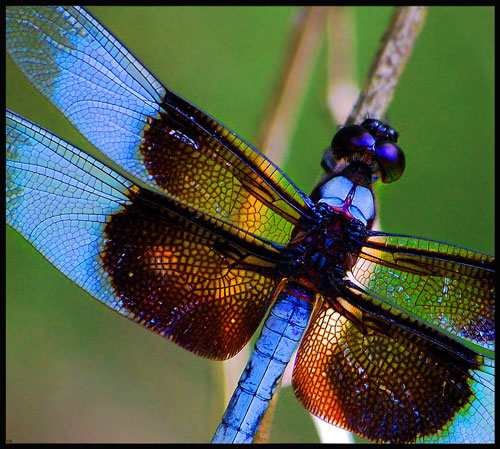
Deep in the sun-searched growths the dragonfly hangs like a blue thread loosened from the sky. by Krikit ♥ on flickr (licensed CC-BY)
(Mostly in this article I refer to Dragonflies, this is just to save constantly writing Dragonflies and Damselflies all the time. The behavior and tips described in this article apply to both Dragonflies and Damselflies.)
Where and when to find Dragonflies
Dragonflies and Damselflies spend most of their lives living underwater as nymphs. They live in fresh water, often preferring ponds and streams. After one to two years living underwater, the nymph climbs up out of the pond and onto a reed or piece of grass at the edge of the pond / river. The dragonfly then sheds its larval skin, and emerges as an adult dragonfly.
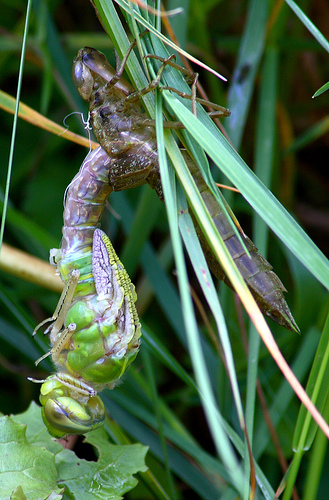
IMG_4638 by richardrichard on flickr (licensed CC-BY-ND)
Typically dragonflies start to emerge around late Spring, finishing in late summer. Generally the water they live in needs to be quite warm before they decide to emerge, so if the weather is cold, you are less likely to find new hatchlings. In the autumn the frost kills the adult dragonflies off. Sometimes they can survive the first few ground frosts, but when it starts to get colder you won't see any more until next year.
The early morning can be a good time for photographing static dragonflies. Sometimes you might find one clinging to a reed near the side of a pond or lake. Insects are cold blooded and need the heat of the sun to warm up before they become active. So early in the morning they are less likely to fly away or move while you are photographing them.

Dewy Dragonfly by George Vnoucek on flickr (licensed CC-BY-ND)
Quite early in the morning is also when you are most likely to see the adults emerging from the skins of their nymphal forms. This can make for some great photos in itself. But also, the dragonfly has to hang around while it first pumps up its wings, and then wait while the wings dry out. So this lets you get quite close without the dragonfly flying away.
Photography gear for photographing Dragonflies
For photographing dragonflies and damselflies, you really need a telephoto focal length. I would suggest a focal length of 50mm at an absolute minimum, and 100mm-200mm is preferable. If you have a camera with a built in zoom lens, then just make sure you zoom in when trying to photograph dragonflies.
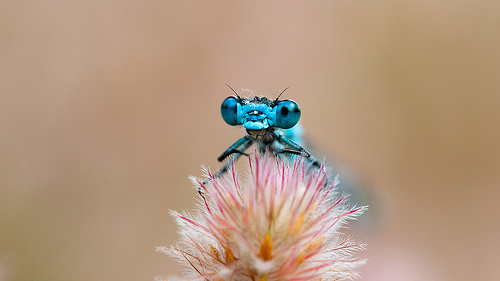
damselfly (sp.) on rabbitfoot clover by JH FIN on flickr (licensed CC-BY-ND)
A wide-angle focal length isn't very useful because dragonflies are so small. For the dragonfly to appear a reasonable size in the image you would need to focus so close to the dragonfly that they would be practically touching the lens.
Lenses longer than 200mm can be used, but these lenses tend to be quite big and heavy. So they are not so comfortable to walk round with while you try to find a dragonfly or damselfly.
As well as using a telephoto lens, the lens must also be able to focus very closely. For interchangeable lens cameras, a macro lens is ideal. If you have a camera with a built-in lens, it may have a 'macro' mode. It is a good idea to test how well this works, as often the 'macro' mode just allows the lens to focus a bit closer than it can normally, which may still not be close enough.
For testing, I would suggest to try focusing on a small pencil. Different dragonflies are different sizes though. If you're after photos of a particular dragonfly (or you know that certain species of dragonflies are common where you will be photographing), then you can lookup the size of the dragonfly on the internet. Then just use a ruler for test photos to make sure your camera can focus close enough to get the shots you want.
If you have an existing camera / lens that can't focus close enough for a good dragonfly photo, you can make it focus closer in a couple of ways:
-
Close-up diopter lenses
These are additional lenses that screw into the filter threads on the front of your lens. They let you focus closer than you normally can, and are measured in diopters. A +3 or +4 diopter close-up filter should be good enough for most dragonfly and damselfly photos.
For more extreme close-ups, a stronger diopter filter, such as the +8 diopter Raynox DCR-250 might be warranted.
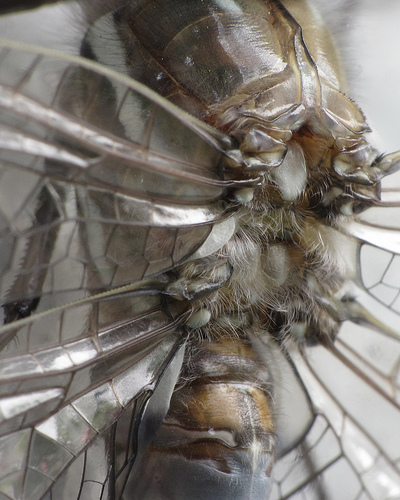
Dragonfly Wings 2 by Jon Garvin on flickr (licensed CC-BY)When purchasing a close-up diopter filter, it is best to stick with the well-known brands such as Canon, Nikon, Olympus, and Raynox. There are many cheap close-up filters for sale on eBay, they will let you focus closer, but many give awful image quality.
-
Extension tubes
For interchangeable lens cameras, you can use extension tubes to make a lens focus closer. These are just hollow tubes that fit between the camera and the lens. The further the lens is extended away from the camera, the closer it can focus.
How much extension you need depends both upon the focal length of the lens, and how close it can normally focus. Most manufacturers sell sets of extension tubes, which include 12mm, 20mm, and 36mm extension tubes. Extension tubes can be stacked, so this gives from 12mm to 68mm of extension. This will be enough for the vast majority of lenses to allow you to focus close enough for dragonfly photography.
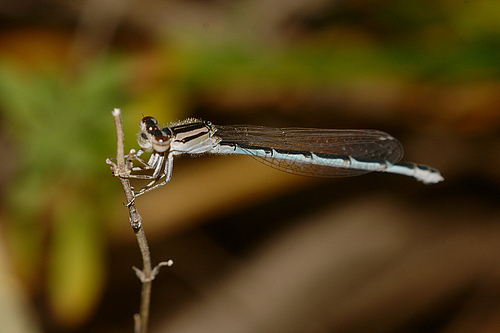
img_7303 by steevithak on flickr (licensed CC-BY-SA)As with diopter filters, there are plenty of cheap extension tubes available on eBay. Although cheap extension tubes won't degrade the image quality (since they contain no optics), they can have a different problem. They don't offer any communication between the camera and lens. This means that you can't control the aperture of the lens from the camera, which can be a problem with lenses that don't have manual aperture rings (most modern lenses).
Generally it is best to stick to new manufacturer branded extension tubes, such as those made by the camera manufacturers and Kenko.
For taking natural light photographs of dragonflies and damselflies in the early morning, you will probably need a tripod. At that time of day the light level is still quite low, which requires a slow shutter speed (or high ISO). Using a tripod will let you use a low ISO and slow shutter speed without risking blurry images from camera shake.
Ronnie Gaubert was undoubtedly one of the masters of dragonfly photography, and he preferred natural light photos, often taken with a tripod. You can see a gallery of Ronnie's dragonfly photos here: IT'S A SMALL WORLD by Ronnie Gaubert 》 THE Odonate Of Louisiana (dragonflies).
Technique for photographing Dragonflies
We've already one technique for photographing dragonflies - get there early in the morning and use a tripod for natural light shots. But sometimes you might want to photograph dragonflies later in the day when they are active, or maybe you want to try and catch one in flight.

Damselfly by Gerald Yuvallos on flickr (licensed CC-BY-ND)
Dragonflies often have a territory that they will patrol. Observing their activity for a while can help you get a better photo. You will probably see that the dragonfly follows a set pattern of patrols. This can help you predict where a dragonfly will fly if you want to get shots of it in flight.
For capturing a dragonfly in flight, make sure that your camera is in continuous autofocus mode, or use manual focus. Try and follow the path of the dragonfly with your camera as it flies past you. Or, look for a spot where it will hover on each patrol. This can be very tricky, but will be easier if you have studied its flight patterns and have an idea where it will go.
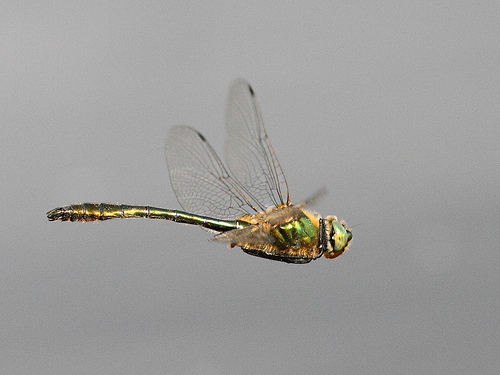
Downy Emerald (Cordulia aenea) - dragonfly in flight by mcamcamca on flickr (licensed CC-BY-SA)
Just as dragonflies have a set patrol route, they often have a preferred perch (or perches). If you can see the dragonfly keeps landing on a certain perch, move next to the perch the next time the dragonfly is patrolling. Hopefully it will come back to the same perch, with you right next to it, ready to take its photo.
When photographing a Dragonfly or Damselfly (or most insects really), it is important to make very slow movements. If you make a fast movement, the Dragonfly will probably view you as a potential threat and fly off.
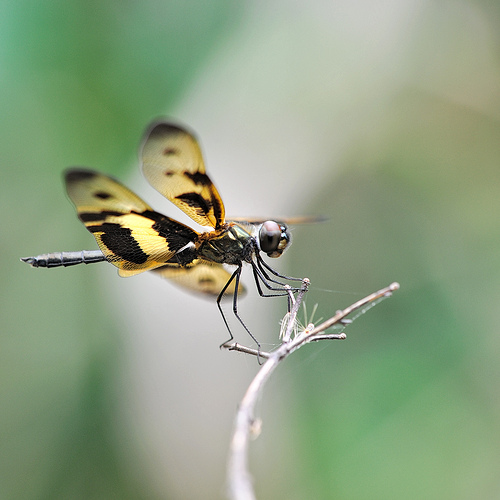
Rhyothemis variegata by Gnilenkov Aleksey on flickr (licensed CC-BY)
Remember that you also need to move the camera very slowly. If you sneak up slowly on a Dragonfly, then quickly bring the camera up to your face, your sneaking will have been a waste of time. However, all is not lost. Be patient and the Dragonfly may well land on that perch again.
Dragonflies and Damselflies aren't the easiest insects to photograph, but their bright colors make them a great subject for photos. If you have some freshwater nearby, try capturing some shots of these fantastic creatures.





Thank you for the very informative article on photographing dragonflies. They have become my new “obsession” and I look forward to implementing new tactics to capture the best images possible. I was very fortunate to be able to observe and photograph 4 pair of mating dragonflies all within close proximity to each other. There are some photos on my website that show the 4 pair together……an awesome moment to be sure! Thank you again for a well written article!